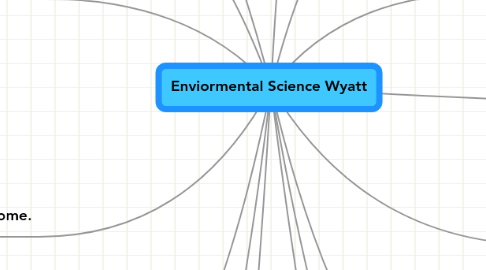
1. Levels organization, smallest to biggest
1.1. Organism
1.1.1. A single living creature.
1.2. Population
1.2.1. A group of the same creature.
1.3. Community
1.4. Ecosystem
1.4.1. A variety of creatures living in the same area. Biotic and abiotic factors interacting.
1.5. Biome
1.5.1. A group of ecosystems in the same area according to climate or location.
2. Different types of biome.
2.1. Temperate Deciduous Forest
2.1.1. A area where trees lose there leaves in the fall. A example of this is most of PA.
2.2. Coniferous Forest
2.2.1. A forest with trees that stay green year round, pine.
2.3. Tundra
2.3.1. A icey land scape with little vegetation, Greenland for example.
2.4. Desert
2.4.1. A hot, dry area that is mostly coverd in sand, Eygpt for example.
2.5. Marine Biome
2.5.1. Areas of salt water that contain a variety of organisms.
2.6. Freshwater Biome
2.6.1. Lakes, ponds, or rivers that contain a variety of fish and other plants and animals.
3. Ecological Succesion
3.1. Primary Succession
3.1.1. Primary succession occurs in areas where there has yet to be a ecosystem like a volcanic island.
3.1.1.1. Pioneer Speices
3.1.1.1.1. The first speices to arrive at a new area and are quick growing weeds and moss.
3.2. Secondary Succession
3.2.1. Secondary Succession occurs in areas where there has already been a ecosystem but it has been destroyed like a abanded feild.
3.3. Climax Community
3.3.1. The max community for a area made up of large oak trees. Also called a
4. Carrying Capacity
4.1. The total population that a ecosystem can carry before the population needs to be reduced.
4.1.1. Limiting Factors
4.1.1.1. Factors that limit the population of a certain area so that it does not reach the carrying capacity.
5. Natural Resources
5.1. Renewable Resources
5.1.1. Resources that the earth can replace during a human lifespan. Cows, trees, and fruits are examples.
5.2. Nonrenewable Resources
5.2.1. Resources that the earth cannot replace in a human lifespan. Examples are diamonds, gold, and uranium.
6. Impermeadable
6.1. Erosion
6.1.1. When the land slowly breaks off due to constant water or other elements pulling the land down.
6.2. Runoff
6.2.1. Any materials that are taken downhill by water. The runoff can be leaves, dirt, oil.
7. Wetlands
7.1. Swampland or land that is verry moist. There are ussually ponds or rivers nearby. They clean out pollution and are a spawning groung for fish and other animals.
8. Biodiverstiy
8.1. Genetic Biodiversity
8.1.1. Animals of the same speices are different on a genetic levels. An example is the different races of humans.
8.2. Speices Biodiversity
8.2.1. A variety of speices living in a area.
8.3. Ecosystem Biodiversity
8.3.1. A varitey of different ecosystems.
8.4. Hot Spots
8.4.1. The areas with the highest levels of biodiverstiy. Ussually along the equator.
9. Trophic Layers
9.1. Producer
9.1.1. Plants that produce there own energy using the sun.
9.2. Primary Consumer
9.2.1. Any animal that only eats plants. Also a herbivore.
9.3. Secondary Consumer
9.3.1. Any creature that eats the primary consumer.
9.4. Tertiary Consumer
9.4.1. Any creature that eats the secondary consumer.
9.5. Decomposers
9.5.1. Any creature that decays dead animals or plants.
10. Factors in a ecosystem
10.1. Biotic Factors
10.1.1. Anything in a ecosytem that is living, was living, or part of a living thing.
10.2. Abiotic Factors
10.2.1. Anything in a ecosystem that never lived or never will live.
11. Population Growth
11.1. Population growth rate
11.1.1. J-Curve
11.1.1.1. When the population continues to grow without stopping. The curve stays steady before jumping up showing a population spike.
11.1.2. S-Curve
11.1.2.1. When the population grows till it hits its carrying capacity. The curve shows this by slowly growing and then hitting a populaiton spike before leveling out.
12. Water Pollution
12.1. Aquifier
12.1.1. Water trapped underground in impermeadable surfaces and sand and silt.
12.2. Desaliniation
12.2.1. Extracting salt from salt water to make it drinkable.
12.3. Water Purification
12.3.1. Removing harmful chemicals and substances from water to clean it for use.
12.4. Watershed
12.4.1. Any area where water drains into and is dumped into rivers which lead out to the ocean.
13. Pollution
13.1. Nonpoint source
13.1.1. Anything laying on the ground that ends up in water. Can only be stopped if people are more wise about what they use.
13.2. Point Source
13.2.1. Pollution that comes from factories and electricity plants. Can easily be cleaned when the source is found.
13.3. Inorganic Pollutant
13.3.1. Pollutants that are manmade in factories like plastic and most rubbers.
13.4. Organic Pollutant
13.4.1. Pollutants that the enviorment makes like animal wastes and dead leaves.
